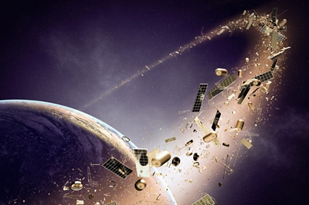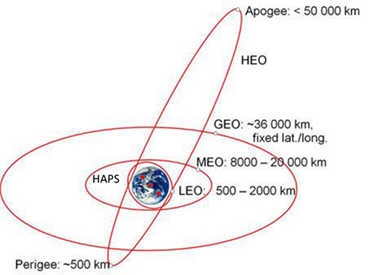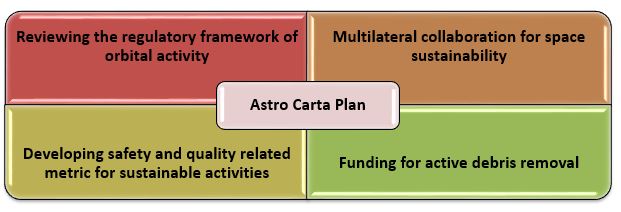Outer Space sustainability model
-
Context:
UK had hosted the fourth summit for Space Sustainability in London in collaboration with the Secure World Foundation.
-
Background:
- Owing to reduced cost and increase in players, Earth’s orbital environment has been tripled in the past decade, increasing the complexities of the missions and slot management.
- Outer space in the 2020s can no longer be considered a ‘space race’, when compared to the beginning of this century.
- Any private or government entity with the necessary access to resources and technology can now invest in the outer space.
- Increasing players and missions have potentially damaged the outer space environment including orbital crowding, space debris and carbon foot prints.
- Sustainable practices in the outer space can reduce the risk of orbital crowding and collision risk while nurturing future technologies.
- K.’s new plan for Space Sustainability aims to set a ‘global commercial framework’ for the insurability, the licensing and regulation of commercial satellites.

-
Analysis
What does sustainability means?
- Space sustainability is ensuring that all humanity can continue to use outer space for peaceful purposes and socioeconomic benefit now and in the long term.
- This will require international cooperation, discussion, and agreements designed to ensure that outer space is safe, secure, and peaceful.
-
What are the dimensions of space sustainability?
- Orbital crowding:
- One of the major issues when it comes to space sustainability is the orbital crowding.
- Orbital crowding poses a direct threat to the operations and safety of a mission and is likely to cause legal and insurance related conflicts.
- Space debris:
- After the completion of the mission, an ‘end of life protocol’ requires space objects to be moved to the graveyard orbit or to a low altitude.
- Neither of the available options are sustainable in long term.
- Graveyard Orbit:
Also referred to as a junk orbit or disposal orbit, it lies higher than the most commonly used orbits of operational satellites. More specifically, it lies at a staggering 22,400 miles (36,050 km) above Earth, which is around 200 miles (321 km) above the farthest active satellites.
- Solar and magnetic storms: Solar and magnetic storms influence the outer space space weather which potentially damages the communication systems. Such space weather threats needs to be addressed.
- Terrestrial carbon foot print: There is an urgent need to identify terrestrial carbon of outer space missions.

UK’s plan of action on sustainable outer space:
- United Kingdom calls for an “Astro Carta” initiative for space sustainability, based on the Artemis Accords model for sustainable space exploration.
- The proposed plan mentions about four primary elements:
- UK has also confirmed investments in its National Space Surveillance and Tracking Programme, which works on the collision of assessment services for U.K. licensed satellite operators.
Key Facts and info:
- Low Earth Orbit: LEO satellites orbit between 2,000 and 200 kilometers above the earth. LEO satellites are commonly used for communications, military reconnaissance, spying and other imaging applications.
- Medium Earth Orbit: MEO satellites orbits between 8,000kms to 20,000kms. MEO has historically been used for GPS and other navigation applications. More recently, HTS MEO constellations have been deployed to deliver low-latency, high-bandwidth data connectivity to service providers, government agencies, and commercial enterprises.
- Geo-Synchronous Orbit: GSO satellites orbits at 35,786kms. A geosynchronous orbit (GEO) is a prograde, low inclination orbit about Earth having a period of 23 hours 56 minutes 4 seconds. A spacecraft in geosynchronous orbit appears to remain above Earth at a constant longitude, although it may seem to wander north and south.
- High Earth Orbits: Satellites stations at more than the height of 35,786 kms are known as HEO satellites.
- Private and Government funding: Post Brexit, the space programmes of U.K. has been transformed, hoping to drive the sustainability factor internationally and provide an opportunity to the private sector to develop models that enhance operations’ safety and reduce debris foot print. U.K has aimed to draw investment from both government and private investors.
India’s approach to sustainable space resource:
- In-SPACe: Indian National Space Promotion and Authorisation Centre had been formally inaugurated, increasing the role of private sectors in India’s space programmes.
- Start-up: India is hosting several promising start ups on developing launch vehicle and power sources of the satellites:
- Agnikul and Skyroot: Start-up to develop launch vehicles for small payloads.
- Dhruva Space: Developing high-tech solar panels for satellites and satellite deployers.
- Project NETRA: ISRO has initiated an action plan to monitor the status of space debris. The domestic surveillance system would provide first-hand information about the space debris and would aid for further planning on protecting space assets.
- SPADEX: ISRO is developing a docking experiment to provide in-orbit servicing. It aims at docking a satellite over an existing satellite, offering support for re-fuelling and other in-orbit services.
- Orbital crowding:
-
What should be done more?
- Collective efforts: The space sustainability can be achieved by the efforts of a single country alone. Active participation and collective efforts are required for the sustainable practices.
- Role of UN COPUOS and UNOSA: Active role of United Nations Committee on the Peaceful Use if Outer Space (UN COPUOS) and United Nations Office for Outer Space Affairs (UNOOSA) is needed to set equitable standards for ease of activities.
- Research and Development: Most of the sustainable practices are resource-consuming and expensive for medium and small space programs. R&D is needed to make the sustainable measures more cost effective and affordable.
- ASAT Threat: Controlled anti-satellite weapons tests and the risk of collision needs to be addressed collectively.
-
Conclusion:
U.K’s Astra Carta idea has thrown an light on the need for addressing the principles and rules guiding the activities of entities in outer space for the sustainability. India has always focused on the cost-effective and efficient missions with the problem-solving applications. Emerging role of private sector could be encouraged with a set of sustainability guidelines to ensure optimum resource utilization and increase the safety and productivity of missions.


